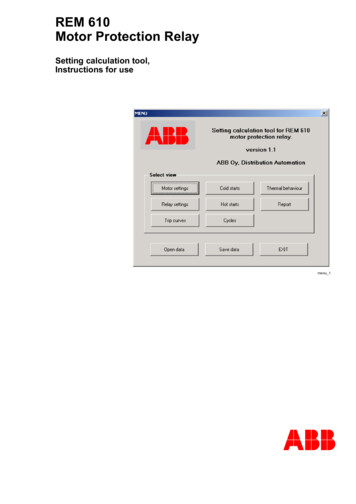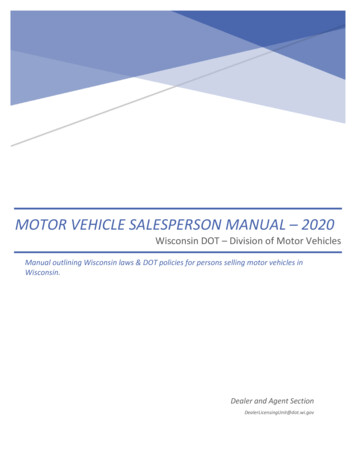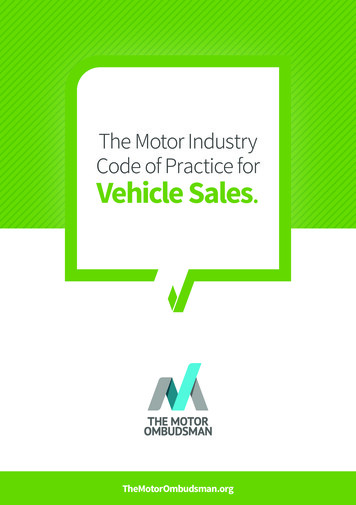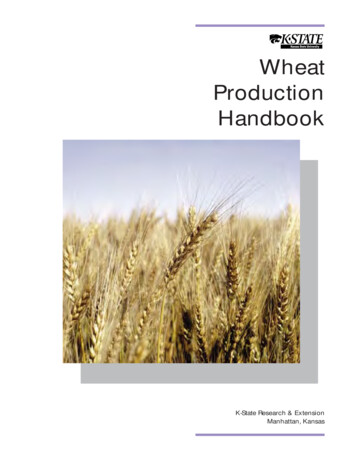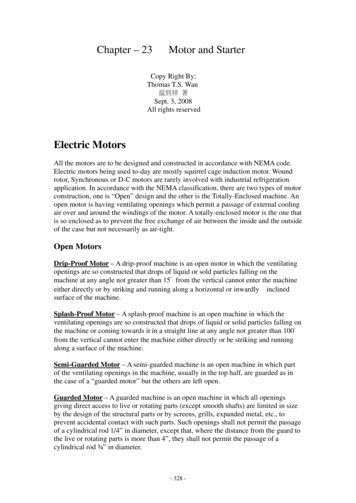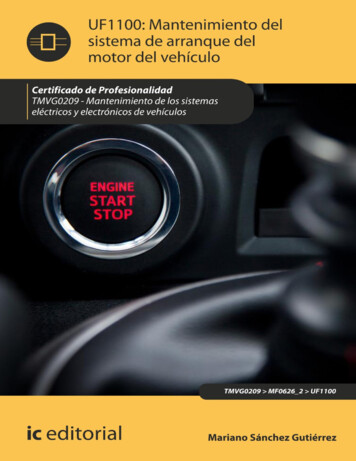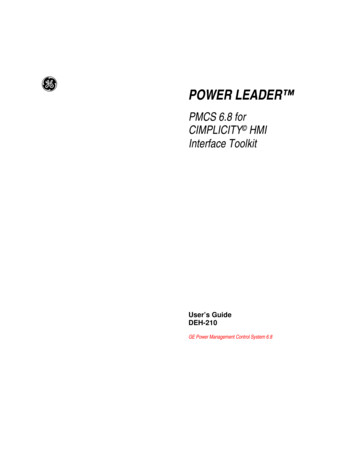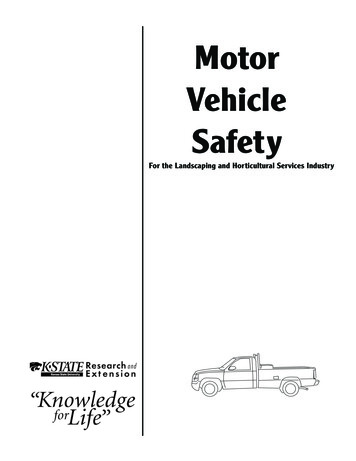
Transcription
MotorVehicleSafetyFor the Landscaping and Horticultural Services Industry
MotorVehicleSafetyContentsIntroductionWhat's Inside? . 3Lesson 1Take Control of Your Own Safety . 4Lesson 2Working Safely Near Traffic . 7Lesson 3Safety Starts Before the Engine . 12Lesson 4Protect Yourself While Driving . 16Lesson 5Operating Large Trucks . 22Lesson 6Pulling Trailers . 27Lesson 7Environmental Hazards . 32Conclusion . 39Quiz Yourself Solutions . 41DisclaimerThis material was produced under grant number 46G3-HT04from the Occupational Safety and Health Administration, U.S.Department of Labor. It does not necessarily reflect the viewsor policies of the U.S. Department of Labor, nor does mentionof trade names, commercial products, or organizations implyendorsement by the U.S. government.This booklet was produced by K-State Research and Extension,Kansas State University, Manhattan, Kansas.2 – Motor Vehicle SafetyThe information in this publication has been compiled from avariety of sources believed to be reliable and to represent the bestcurrent opinion on the subject. However, neither K-State Researchand Extension nor its authors guarantee accuracy or completenessof any information contained in this publication, and neitherK-State Research and Extension or its authors shall be responsiblefor any errors, omissions, or damages arising out of the use of thisinformation. Additional safety measures may be required underparticular circumstances.
What’s Inside?This book teaches important safety practices for operating andworking near motor vehicles. It is designed to use with youremployer’s safety training, the vehicle operator’s manual, and yourstate driver’s license manual. Information in this book reinforcessafe operation of a motor vehicle in work-related situations.Motor Vehicle Safety – 3
Lesson 1Objective1. Identify the leading cause ofaccidental death on the job.2. Identify safe work habitsoperating motor vehicles.Take Chargeof Your Own SafetyGreatest DangersWorkers are more likely to be seriously injured or killed in incidents involving motor vehicles than from any other workplacehazard. The most commonly reported causes of job-related vehicledeaths and serious injuries are:1. Being hit by traffic while working near a roadway.Accident ReportEmployee Killed At IntersectionSummary of OSHA Accident Inspection 125269456An employee was working near a busy intersection when hewas struck by an automobile. The driver of the automobilestated he did not see the employee. The employee was notusing any reflective equipment or clothing; the worksite wasnot illuminated; and the highway warning signs were notdisplayed properly. The employee died at the scene.Protect yourself and your coworkers, usereflective equipment, clothing and warningsigns.2. Accidents at the job site.Accident ReportEmployee Ran Over By TruckSummary of OSHA Accident Inspection 102919206An employee was standing in a loading area occupied byseveral trucks. Another driver did not see him and backed atruck over him. The employee was killed.Check for coworkers and warn them beforebacking.4 – Motor Vehicle Safety
3. Crashes driving to, from or between job sites.Accident ReportEmployee Killed In Fall From PickupSummary of OSHA Accident Inspection 112891445Two employees were riding home from work in the back of acoworker’s pickup. One of the riders fell off the open tailgateand struck his head on the ground. He was killed.Never ride or transport passengers in the bedof a pickup.Never ride or transportpassengers in the bedof a pickup.Help YourselfSafe work habits are important. Here are three actions you cantake to be safe on the job site.1. Prepare for safe drivingYou must have a valid driver’s license to drive on public roads.Read the operator’s manual for each vehicle you will bedriving and know your company’s driving policies.2. Concentrate on working safelyWhether you are the driver or a passenger, always wear yoursafety belt. Obey all traffic signs and signals. Risks andshortcuts can lead to serious injury and death.3. Additional PrecautionsDo not operate machinery if you are tired or have taken drugsor alcohol. If you are on medication, discuss with your doctoror pharmacist if you are able to safely operate vehicles andmachinery.ChoosesafetyMotor Vehicle Safety – 5
Quiz YourselfAnswers can be found on page 41.Use the list of words to complete the following sentences.public roadwaydrugsincidentssafety belt1. Motor vehicle are the leading causeof accidental death in the workplace.2. When operating a motor vehicle you should always wearyour .3. To operate a motor vehicle on a , youmust have a valid driver’s license.4. Never operate a vehicle if you are under the influence ofor alcohol.6 – Motor Vehicle Safety
Working SafelyNear TrafficFrom time to time your work site may be located near a roador street. Try to schedule jobs so you are not working in heavilytraveled areas during morning and evening rush hours and atdusk or in darkness. Take steps to protect yourself, coworkers andequipment from traffic.Accident ReportEmployee Killed While Working in Median StripSummary of OSHA Accident Inspection 119565737Lesson 2Objectives1. Identify safety procedures touse when working on or nearthe shoulder of the roadway.2. Recall how to use trafficcontrol devices in your workzone.An employee was struck and killed by a car while working inthe median. There were safety vests, traffic warning signs andsafety cones in the company van, but the workers did not useany of them.Protect yourself and your coworkers, wearsafety vests, use traffic warning signs andsafety cones.Temporary Traffic Control ZoneA temporary traffic control zone is an area where road userconditions are changed because of a work zone or an incident.Although each zone is different, the goal of your work should be toperform your work safely and with as little disruption to road usersas possible.Temporary traffic control devices such as warning signs and conesare placed in the zone. Their installation and maintenance shouldcomply with the Manual on Uniform Traffic Control Devices(MUTCD), http://mutcd.fhwa.dot.govThe MUTCD covers three distinct work zones: construction,maintenance and utility work. To be effective, traffic controldevices should meet five basic requirements:4Fulfill a need4Command attention4Display a clear, simple meaning4Command respect from road users4Give adequate time for proper responseChoosesafetyMotor Vehicle Safety – 7
General Temporary Traffic Control GuidelinesIf you will be working 60 minutesor less, a vehicle with activatedhigh-intensity rotating lights may beused in place of a sign, cones andbarricades.8 – Motor Vehicle Safety1. Notify local police before starting a job that might interferewith traffic flow.2. All equipment, vehicles and materials should be stored awayfrom traffic to avoid collision.3. Wear highly-reflective, brightly-colored vests and clothingto make yourself visible to traffic.4. Use highly-visible signs, cones and barricades to warn anddirect traffic and protect you and your coworkers whileworking.5. All warning signs, cones and barricades should be easy-toread and clean to maintain maximum visibility.6. Remove or cover warning signs when the job is finished oryou are not working.7. When you must leave vehicles unatttended, remember to rollup all windows, remove the keys and lock all the doors.
Work Beyond the ShoulderWhen you are working beyond the shoulder, but within theright-of-way, minimal traffic control is required. Generally, ifthe work is 15 feet or more from the edge of the traveled way, ortwo feet from the curb, no control devices are needed.You should use a single warning sign when work lasts longerthan 60 minutes and when any of the following situations exist:4Vehicles are parked on the shoulder4Equipment is traveling on or crossing the roadway frequently4Work is within 15 feet of the traveled way4Work is within two feet of the curbAppropriate warning signs for work beyond the shoulderinclude ROAD WORK AHEAD or SHOULDER WORK.If you will be working 60 minutes or less, a vehicle withactivated high-intensity rotating light may be used in place of asign, cones and barricades.Temporary TrafficControl Devices forWork Beyond theShoulderShoulderRoad Work SignWork Sign Spacing WORK AREA(see chart below)Work Sign Spacing (ft)To Find the Distance to the SignUrban(40 mph or less)100Urban(45 mph or more)350If you are working beyond the shoulder,you will only need one sign. Use the charton the left to match the type of road youare working on to the distance (ft) in thefirst column.Road TypeRuralExpressway5001000Motor Vehicle Safety – 9
To Find the Shoulder TaperDistance from the work area to the leadcone or barricade of the shoulder closurewidth width of one lane of trafficspeed normal speed of roadFor speeds of 45 mph or more:shoulder taper width x speed 3Work On the ShoulderWhen you are closing a shoulder that is eight feet wide or more,you must add another warning sign. The general warning sign,such as ROAD WORK AHEAD should be used, followed bya SHOULDER CLOSED sign. You should also use cones andbarricades to close the shoulder and direct traffic to remain withinthe traveled way. This is called a shoulder taper.For speeds of 40 mph or less:shoulder taper width x speed2 60 3Temporary TrafficControl Devices forWork On the ShoulderExample:If you are working on the shoulder of ahighway with 10 ft lanes and a postedspeed limit of 60 mph, the shoulder taperwould be.10 x 60 3 200 ft of shoulder taperExample:If you are working on the shoulder of ahighway with 10 ft lanes and a postedspeed limit of 40 mph, the shoulder taperwould be.10 x 402 60 3 89 ft of shoulder taperEnd RoadWork SignCones or Barricades ShoulderTaper WORK AREAShoulderClosed Sign End RoadWork SignWork Sign Spacing (ft)How to Find the Distance Between SignsRoad TypeABUrban(40 mph or less)100100Urban(45 mph or more)35035050050010001500RuralExpressway10 – Motor Vehicle Safety Road WorkSignShoulderRoad WorkSignIf you are working on the shoulder, you willneed two signs to warn road users. Usethe table to match the type of road with thedistance you need between the signs.Shoulder ClosedSign
Quiz YourselfAnswers can be found on page 41.1. Use the list of words below to complete the followingsentences.slow downtaperrush hoursequipmentbeyondclothinga. Place warning signs far enough ahead of the work site sodrivers have time to react andb. Wear highly-reflective, brightly-coloredwhen working near traffic.c. Keep away from the road so it will notinterfere with traffic flow.d. Whenever possible, plan to avoid working near busy roadsduring .e. If you are working the shoulder, only onewarning sign is required.f. When working on the shoulder, the shoulder isthe distance from the work area to the lead cone or barricadeof the shoulder closureMotor Vehicle Safety – 11
Lesson 3Objectives1. Recall safe start up and shutdown procedures of your vehicle.2. Recognize how to safely park onhills.Safety StartsBefore the EngineSafe motor vehicle operation begins before you start the engine.You can help prevent accidents by performing a pre-startinspection of the vehicle and towed equipment. Alert yoursupervisor if you find anything wrong during your inspection.Accident ReportEmployee Injured When Brakes FailSummary of OSHA Accident Inspection 115171472An employee was operating a dump truck when the brakesfailed. The truck rolled backward down a hill, then off theroadway and over a steep bank. The employee was thrownfrom the vehicle and suffered severe injuries.Conduct a daily safety inspection. If somethingis not working properly, alert your supervisor.Daily Safety InspectionEach day, check the vehicle you are using before start up.Your inspection should include:Fuel and Fluid LevelsCheck the fuel gauge before you start. Periodically check oil,transmission, brake and washer fluid levels to make sure theymeet your vehicle’s operator’s manual.TiresWalk around the vehicle and towed equipment and inspectthe tires. Check tire pressure and look for signs of damage orexcessive wear. Make sure lug bolts are tight.Safety BeltsMake sure all safety belts are functioning, and everyone isproperly restrained.ControlsCheck the horn to make sure it works. Test the lights, turnsignals and windshield wipers before you begin.BrakesMake sure your brakes are working properly. Test according toyour vehicle’s operator’s manual.12 – Motor Vehicle Safety
Windshields and MirrorsMake sure the windshields and mirrors are clean. Adjustmirrors so you can see properly.Driver’s LicenseYou must have a valid driver’s license in your possession whileoperating a motor vehicle. mployee Run Over At Job SitePre-Start Checklisto Fuel and Fluid Levelso Tireso Safety Beltso Controlso Brakeso Windshields and Mirrorso Driver’s LicenseSafe Starting1. Walk around the vehicle to make sure no people orobstacles are in your path.2. Buckle up before you start the engine. Wear a safety belt toreduce the risk of serious injury or death.3. Make sure the transmission is in park for automatictransmissions or neutral for standard transmissions. Mostautomatic vehicles will not start when the vehicle is in gear.For standard transmissions, make sure the parking brake is setand the transmission is in neutral, so the vehicle doesn't move.4. Adjust the seat, side and rear view mirrors. Adjust theseat so your feet reach the pedals, and your hands reach thesteering wheel and controls. Adjust the seat so you have aclear line of sight through windows and mirrors as well.5. Start the engine as recommended in the operator’s manual.Wear Your Safety BeltWearing your safey belt cuts your risk of beingkilled in a vehicle accident by half.To provide protection, the lap portion of the safetybelt must be worn low and snug across the hips,and the shoulder portion must be snug across thechest, away from the neck and face. Adjust yourseat to ensure your safety belt is worn properly.Motor Vehicle Safety – 13
Always set the parking brakewhen parking on a hill.Safe ShutdownWhen it is time to shut down your vehicle you should:1. Park on a level surface, if possible. If you have to park on aslope, you must adjust your front wheels to prevent the vehiclefrom rolling into traffic. If facing uphill with a curb, turn thewheels away from the curb. Otherwise, turn the wheels towardthe curb or roadside. Always engage the parking brake.2. Secure the vehicle.a. For automatic transmissions put the vehicle in park.b. For standard transmissions put the vehicle in first gear orreverse and set the parking brake.3. Turn the engine off and remove the key from the ignition.4. Unbuckle your safety belt.5. Lock all doors and roll up windows before leaving the vehicleunattended.How To Park On Hills14 – Motor Vehicle SafetyDOWNHILLWith or WithoutCurbUPHILL With CurbUPHILL Without CurbTurn WheelsTOWARD theCurb or RoadsideTurn Wheels AWAYFrom the CurbTurn WheelsTOWARD theRoadside
Quiz YourselfAnswers can be found on page 42.Use this list of words to complete the following sentences.fuel and fluidtowardparking brakesafety beltaway fromdaily1. Wearing your cuts your risk ofserious injury or death from a motor vehicle crash in half.2. Before driving, check the levels.3. When a vehicle is facing downhill with or without a curb, turnthe wheels the curb or roadside.4. When you must park on a slope, engage theso the vehicle will not roll.5. When a vehicle is facing uphill with a curb, turn the wheelsthe curb.6. As part of your pre-start safety inspection,inspect the tires on your vehicle and all towed equipment.Motor Vehicle Safety – 15
Lesson 4Objectives1. Recognize factors thatcontribute to motor vehiclecrashes.2. Identify ways to preventcrashes.3. Interpret the meaning of trafficsigns.Protect Yourself WhileDrivingSafe driving means recognizing, assessing and responding topotentially dangerous situations.Accident ReportEmployee Killed Driving to Job SiteSummary of NIOSH FACE Report 91WY010An employee was driving a company pickup to a work site. Hehad been working overtime and traveling between work sitesthe entire week. Halfway to his destination he ran into theback of a tanker truck and was killed. According to an accidentinvestigation, no attempt was made to avoid hitting the tankerand distraction and fatique led to the accident.Do not drive or operate equipment when fatigued.Avoid distractions while driving.Examples of mistakes made by drivers include:4Driving over the speed limit or too fast for road conditions4Being distracted4Driving under the influence of alcohol, drugs or when fatigued4Improper vehicle maintenanceAccident ReportTruck Driver Killed in CrashSummary of HWY-98-SH-003A truck driver drove off a highway, struck a ditch embankment,became airborne, and landed on top of a stopped pickup. Thetruck driver and the two occupants of the pickup were killed. Aninvestigation revealed the driver had been taking prescriptionpain medicine that made him drowsy.Do not operate a motor vehicle if you are usingprescription drugs that may cause impairment.Safety startsbefore the engine16 – Motor Vehicle Safety
Protect YourselfSafe driving begins with you.1. Keep both hands on the steering wheel at all times.2. Be aware of what traffic around you is doing.3. Avoid other vehicle’s blind spots.4. Obey all traffic signs and signals.5. Leave enough distance between you and the vehicle in frontof you to stop safely.Accident ReportSix Employees Injured In AccidentSummary of OSHA Accident Inspection 124815366An employee was driving a van full of coworkers on awinding, downhill road. Despite his coworker’s requests forhim to slow down, he refused. The driver lost control andthe speeding vehicle plunged more than 400 feet down asteep embankment. Four employees were ejected and hadto be airlifted to a hospital were they were treated for seriousinjuries.Obey speed limits and drive slower in dangerousroad conditions.Safe SpeedSpeeding causes many motor vehicle crashes. Speed limits indicatethe highest speed at which it is safe to drive on that road. You needto drive slower than the posted speed limit in poor weather or indangerous road conditions. Always take into consideration the sizeand weight of a towed load.Motor Vehicle Safety – 17
Driver DistractionWhen you are behind the wheel, your job as a driver requires fullattention. Distractions slow your ability to respond to changingconditions. Distractions can be physical, mental, or both.DIAMOND meansGeneral WarningSQUARE meansTraffic RegulationsRECTANGLE (long axisvertical) meansTraffic RegulationsNOPASSINGZONEYIELDTRIANGLE meansYieldROCTAGON meansStopPENNANT meansNo Passing1. Physical distractions require you to take your eyes off theroad or remove your hands from the steering wheel. Examplesof physical distractions include: adjusting vehicle controls,cell phone calls, eating and drinking. Designate a passenger toanswer the phone or two-way radio or pull off the road and stopthe vehicle before you begin the conversation. Adjust controlsbefore you begin driving.2. Mental distractions take your focus off driving. Examples ofmental distractions include conversations with passengers or ona cell phone, daydreaming, being frusturated, upset or otherwisedistracted. Make an effort to clear your mind of distractionsand concentrate on safe driving.Research has proven that drivers who use cell phones in theirvehicles have a higher risk of collision than drivers who donot. In addition, driving records revealed that cell phoneusers receive more traffic citations.RCIRCLE meansRailroad CrossingRECTANGLE (long axishorizontal) meansDirectional InformationDriving in All Types of WeatherYou will probably have days when driving conditions are poorbecause of the weather. Below are some tips for managingweather-related driving conditions.PENTAGON meansPedestrian TrafficRain4Slow down and allow extra space between you and the vehicle infront of you when driving on wet pavement.4Use the windshield wipers.4Use headlights on low beam to make your vehicle visible toother drivers and to help you see the road if it is dark. Lowbeams cause less reflection during rain.4Do not drive in standing or flowing water. Your vehicle could beswept away by the water or the engine could stall, leaving youstranded.18 – Motor Vehicle Safety
Accident ReportEmployee Crashes Into Tanker Truck And SemiSummary of OSHA Accident Inspection 115165011On an overpass, an employee’s truck struck ice, skidded intoa tanker truck, then collided with a semi-tractor head-on. Theemployee was not wearing his safety belt and died.Always wear your safety belt. Drive slower inpoor weather conditions.Snow/Ice4Scrape snow and ice from windshield for better visibility.4Drive slower and increase following distance. Even snow tiresslide on ice or packed snow.4Watch for slick spots on bridges and overpasses.Fog4Turn headlights on low beam and use fog lamps, if available.4Fog decreases your visibility. Drive slower and increasefollowing distance.Wind4Increase your following distance so you have time to react toevents around you, such as objects blowing across the road orthe vehicle in front of you slowing or stopping suddenly.4Keep both hands firmly on the steering wheel, so you maintaincontrol of the vehicle.4Be cautious when pulling a trailer in the wind. The wind willpush and tug at the trailer making driving difficult.Motor Vehicle Safety – 19
Slow Moving Vehicle EmblemOrangeTriangleRed RetroreflectiveBorderPavement markings indicate:4Where on the roadway you should drive4Passing and no passing zones4Road edgesPavement marking colors:4YELLOW lines divide 2-way traffic4WHITE lines divide same way trafficSlow Moving Vehicle (SMV) EmblemA vehicle that cannot travel over 25 mph must display aSlow Moving Vehicle (SMV) emblem. The SMV emblem isan orange triangle (visible in daylight) with a red retroreflectiveborder (visible at night). It is a universal symbol indicating thevehicle is moving at 25 mph or slower. An SMV emblem doesnot replace other vehicle warning devices such as tail lights,flashers or reflectors. The SMV emblem must be visible from atleast 600 feet from the rear of the vehicle or towed equipment.The mounting height may vary from 2 to 10 feet above the roadsurface with the point of the triangle up. Never display an SMVemblem on a vehicle or trailer that will be moving faster than 25mph.Changing Lanes Safely1. Always signal when making a lane change2. Before changing lanes, check the mirrors and look for vehicles3. Obey all posted traffic signs, signals and pavement markingsDriver/Operator ImpairmentNever drive while fatigued or under the influence of drugs traffic.Passingpermittedin lane withdashed line.1. Alcohol and drugs affect your ability to think clearly and reactquickly. Prescription and nonprescription drugs may affect yourdriving. Ask a pharmacist or doctor if your medicine will affectyour ability to drive and operate machinery.2. Fatigue affects your safety and can put others in danger. Makesure you get adequate rest before work.3. Take short breaks frequently, especially if you are driving or seatedfor extended periods of time. Stand up, stretch, walk around orget something to drink. Any activity will help refresh you.No passingeitherdirection.Multi-lane, two-wayroad.Accident ReportEmployee Crashes Into Tanker Truck And SemiSummary of OSHA Accident Inspection 115158206An employee lost control of the vehicle she was driving andwas killed. She had an elevated blood alcohol level. Shewas exceeding the speed limit and not wearing her seat beltat the time of the accident.Never drink and drive.20 – Motor Vehicle Safety
Quiz YourselfAnswers can be found on page 43.1. Match the traffic sign with its meaning.StopPedestrian TrafficNo PassingYield2. Use this list of words to complete the following sentences.lane changedrivingovera. To avoid distractions, do not answer cell phone calls while.b. Always signal when making a .c. Always display an SMV emblem on a vehicle or trailer thatcannot travel 25 mph.Motor Vehicle Safety – 21
Lesson 5Operating Large TrucksObjectivesFully loaded trucks are slower and more difficult to steer thanpassenger vehicles. Hauling heavy loads to and from job sitesrequires special training and knowledge.1. Identify safe loading andunloading procedures.2. Recognize safe operatingprocedures when driving bigtrucks.Accident ReportEmployee Dies In Crash At Job SiteSummary of FACE Report 92-19An employee was driving a large water tank truck on a jobsite. His truck and another vehicle approached head-on. Theemployee swerved, but hit the front tire and fender of the othervehicle. His truck overturned and the employee died. He wasnot wearing his safety belt.Large trucks can overturn easily. Alwaysfasten your safety belt.Safe Loading and Unloading1. Load and unload on a level surface.2. Use wheel blocks to keep the truck from moving duringloading and unloading.3. Do not overload the truck. An overloaded truck is harder tosteer and stop. Heavy loads also put additional stress on tires,brakes, suspension, the cooling system and the drive train. Lookfor load limits on the truck’s data plate and operator's manual.4. Be careful loading high-profile cargo. Make sure cargo willnot hit overhead power lines, highway overpasses or bridges.Accident ReportWorker Backed Over By Dump TruckSummary of FACE Report 2002-06A loaded dump truck entered a work zone. The driverpositioned the truck so he could back up to unload. He sawa coworker standing near his unloading site. He believed theworker had moved, and began backing up. The worker hadnot moved, and was killed when the dump truck ran over him.Know where your coworkers are beforemoving trucks and motor vehicles.22 – Motor Vehicle Safety
Driving Loaded Trucks Safely1. Have a valid driver’s license or a Commercial Driver’sLicense (CDL) if necessary. Follow licensing laws for yourstate.Did You Know?It takes about twice the distance to stop aheavy truck as it does a passenger vehicletraveling at the same speed.2. Allow extra space between you and the vehicle in front ofyou. Also allow extra time to pass. A loaded truck takes longerto accelerate to highway speed and longer to stop. Watch forcars pulling out in front of you and be ready to react.3. Be aware of blind spots, especially when turning and makinglane changes. Big trucks have blind spots: directly in front, oneither side and directly behind the truck. The size of the blindspot varies with the size of the truck.4. Be aware of where coworkers are before moving.Accident ReportEmployee Struck and KilledSummary of OSHA Accident Inspection 116426586An employee was landscaping on a job site where a tractortrailer had just dropped off a connection box. The driver of thetractor trailer was backing up in preparation for pulling onto theroadway when he hit the employee. He was killed.Inspect the scene and warn coworkers beforebacking up.5. Use the horn to indicate when you are backing unless thetruck is equipped with an automatic back up alarm.6. Know the characteristics of the load you are carrying.4Make sure high profile loads will not contact overheadpower lines, bridges or overpasses.4Materials such as gravel or dirt may shift during turnscausing the truck to become out of balance and tip over.4Liquids carried in a tank will shift if the tank is not full,making it difficult to control the vehicle.Motor Vehicle Safety – 23
Did You Know?Federal, state, and local regulations for vehicleweight, securing cargo, covering loads,and where you can drive large vehiclesvary.Know the rules where you will bedriving.7. Indicate oversized loads with signs. Signs are normally placedon the back of any load that extends beyond the end of thetruck or is wider than the truck bed. Follow your state’s laws formarking oversized loads.8. Never carry people in the cargo area of the truck. They canfall or be thrown.9. Set the parking brake when the truck is parked so it will notroll. If you have to park on a slope, you must also adjust yourfront wheels to prevent the vehicle from rolling into traffic. Iffacing uphill with a curb, turn the wheels away from the curb.Otherwise, turn the wheels toward the curb or roadside. Alwaysengage the parking brake.Special Precautions for WorkingWith Dump TrucksAccident ReportEmployee Crushed Between Truck Bed and FrameSummary of OSHA Accident Inspection 000729756An employee raised the bed of a 2-ton dump truck to addhydraulic fluid to the reservoir. He did not use a lift supportto secure the bed. While he was adding hydraulic fluid, thebed fell and crushed him to death. A lift support device wasavailable, but he had choosen not to use it.Never work under a raised, unsupported,truck bed. Always use lift support.1. Only raise the bed with the truck parked on level ground. Araised bed increases the truck’s center of gravity. Side overturnsare common on sloped ground or when the truck is turningwith the bed raised.2. Check for clearance before raising the bed and dumping.Be aware of the location of overhead wires, obstructionsand people when dumping. When necessary, have a coworkerdirect you to the unloading area.24 – Motor Vehicle Safety
Accident ReportEmployee Crushed Betwee
the traveled way. This is called a shoulder taper. If you are working on the shoulder, you will need two signs to warn road users. Use the table to match the type of road with the distance you need between the signs. How to Find the Distance Between Signs WORK AREA Shoulder Closed Sign End Road Work Sign End Road Work Sign Shoulder Taper Cones .
